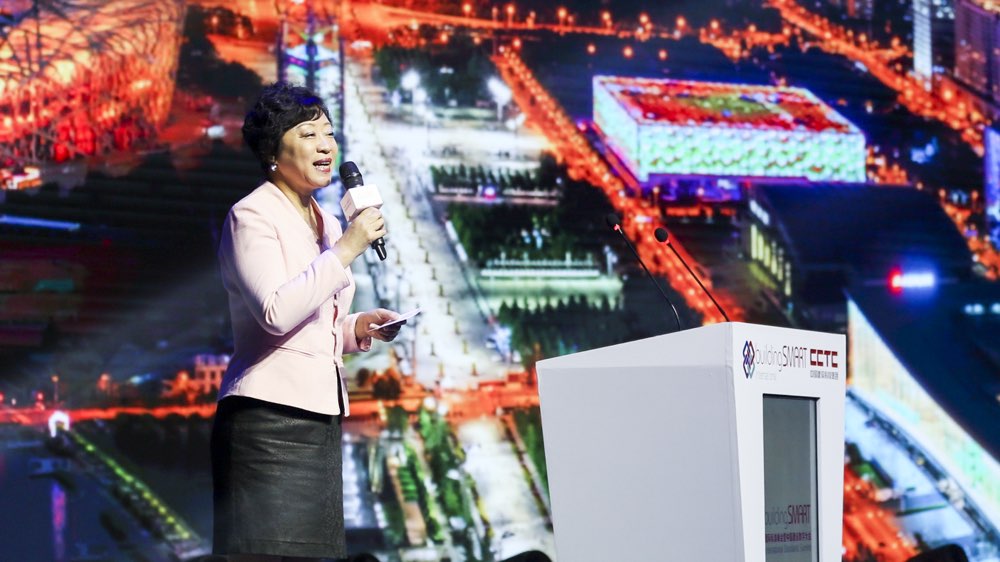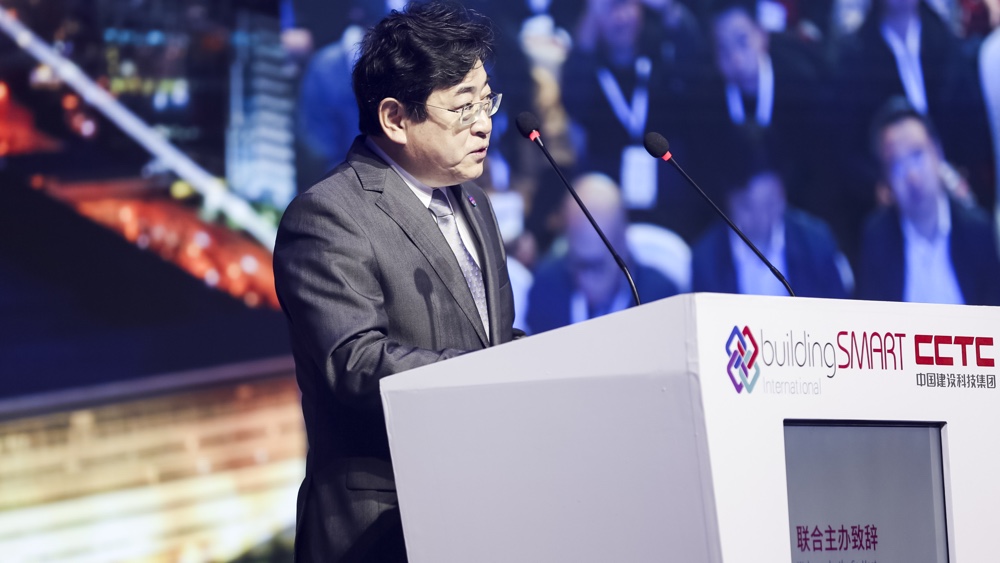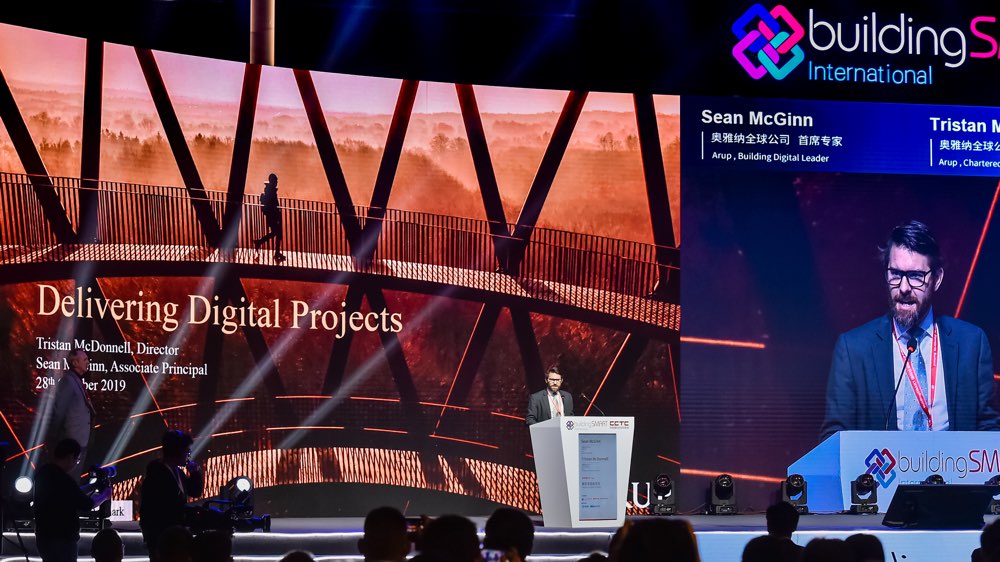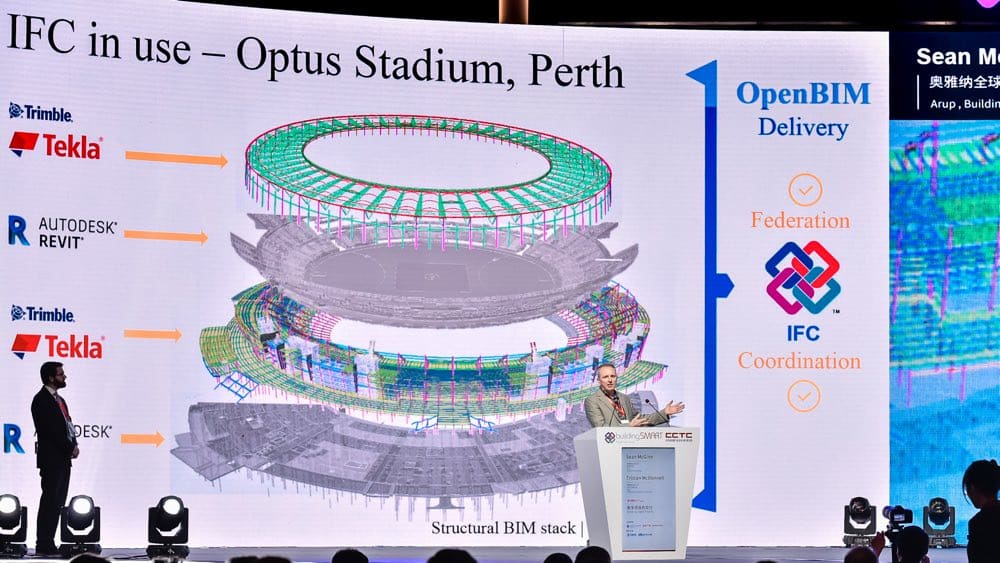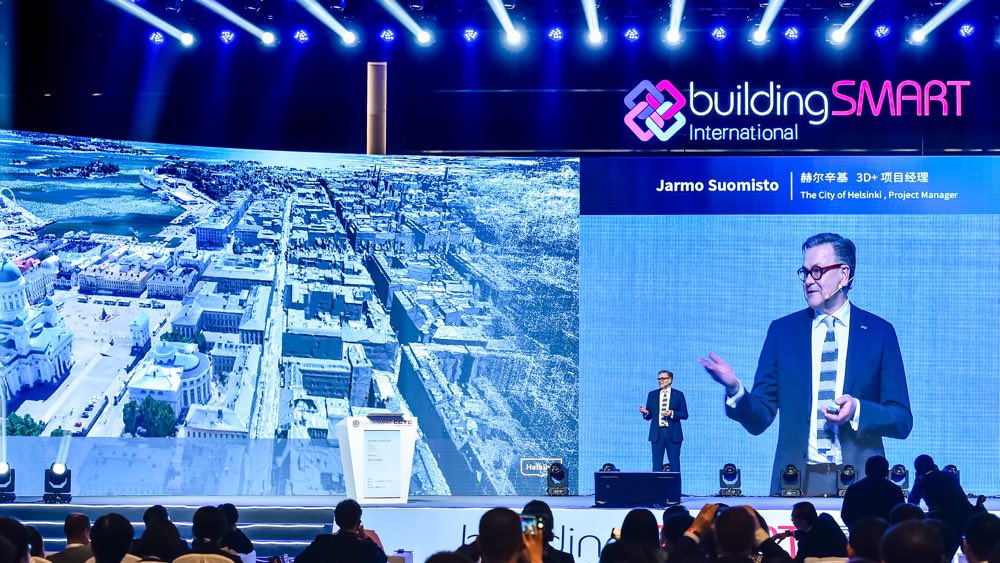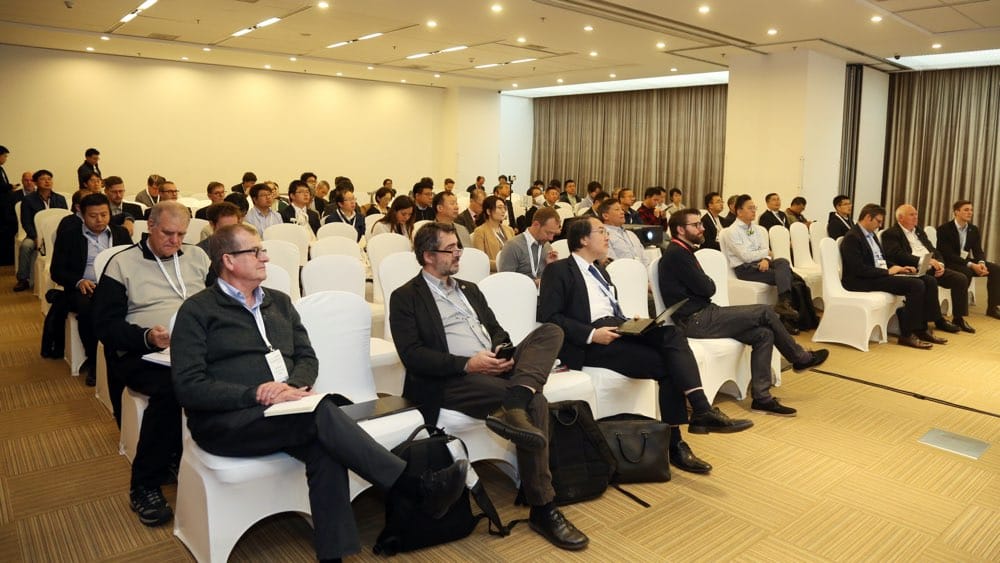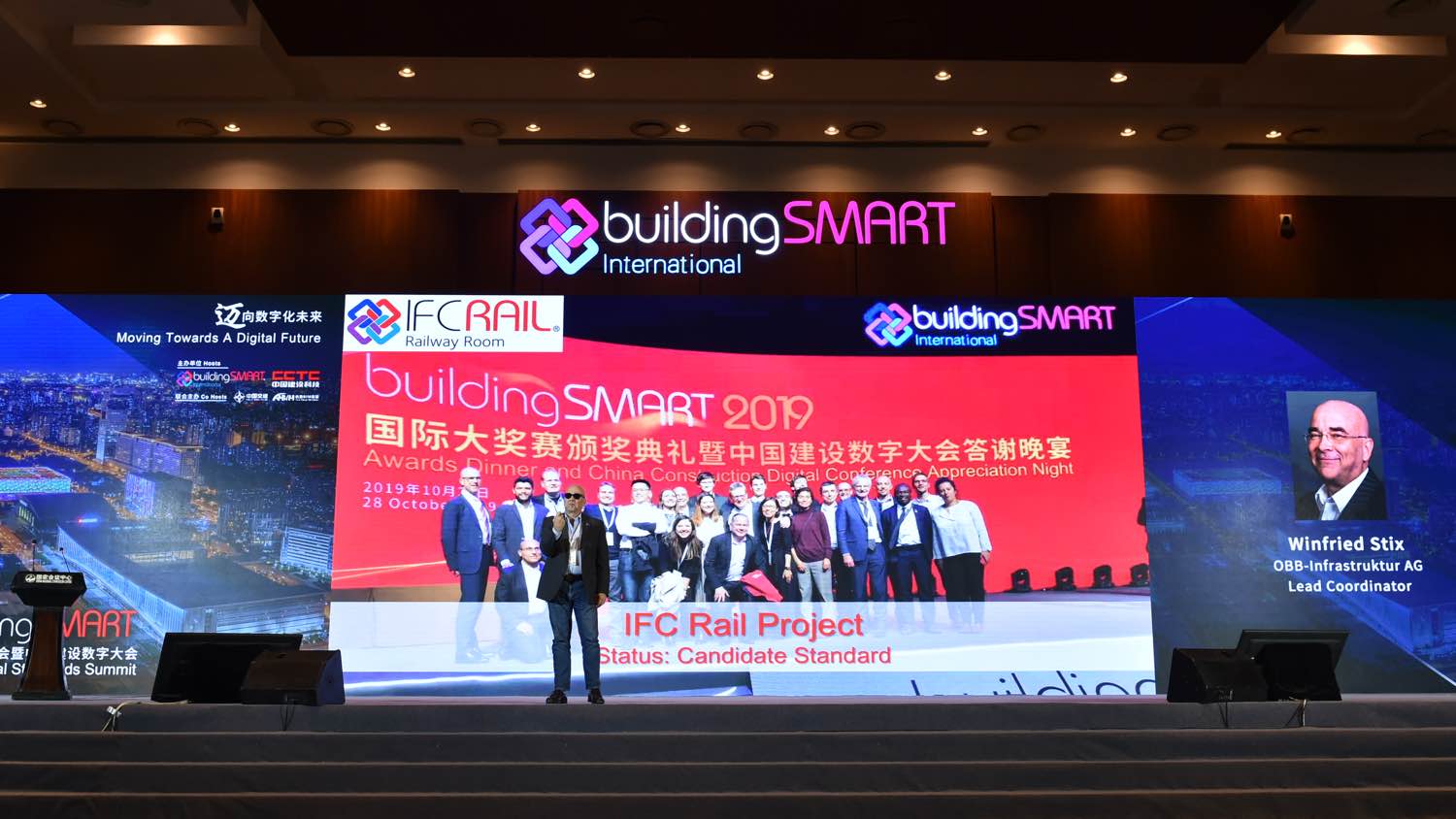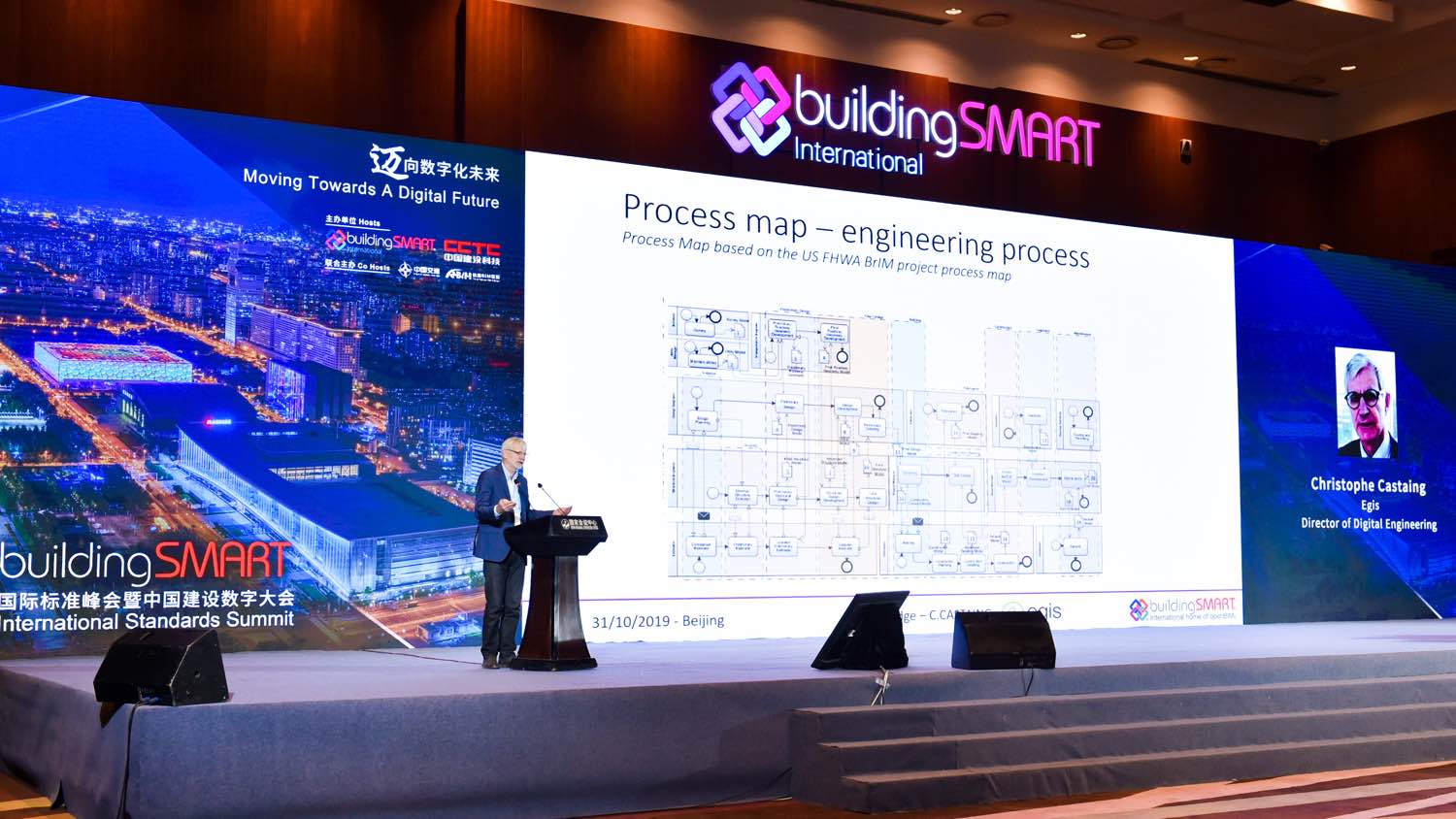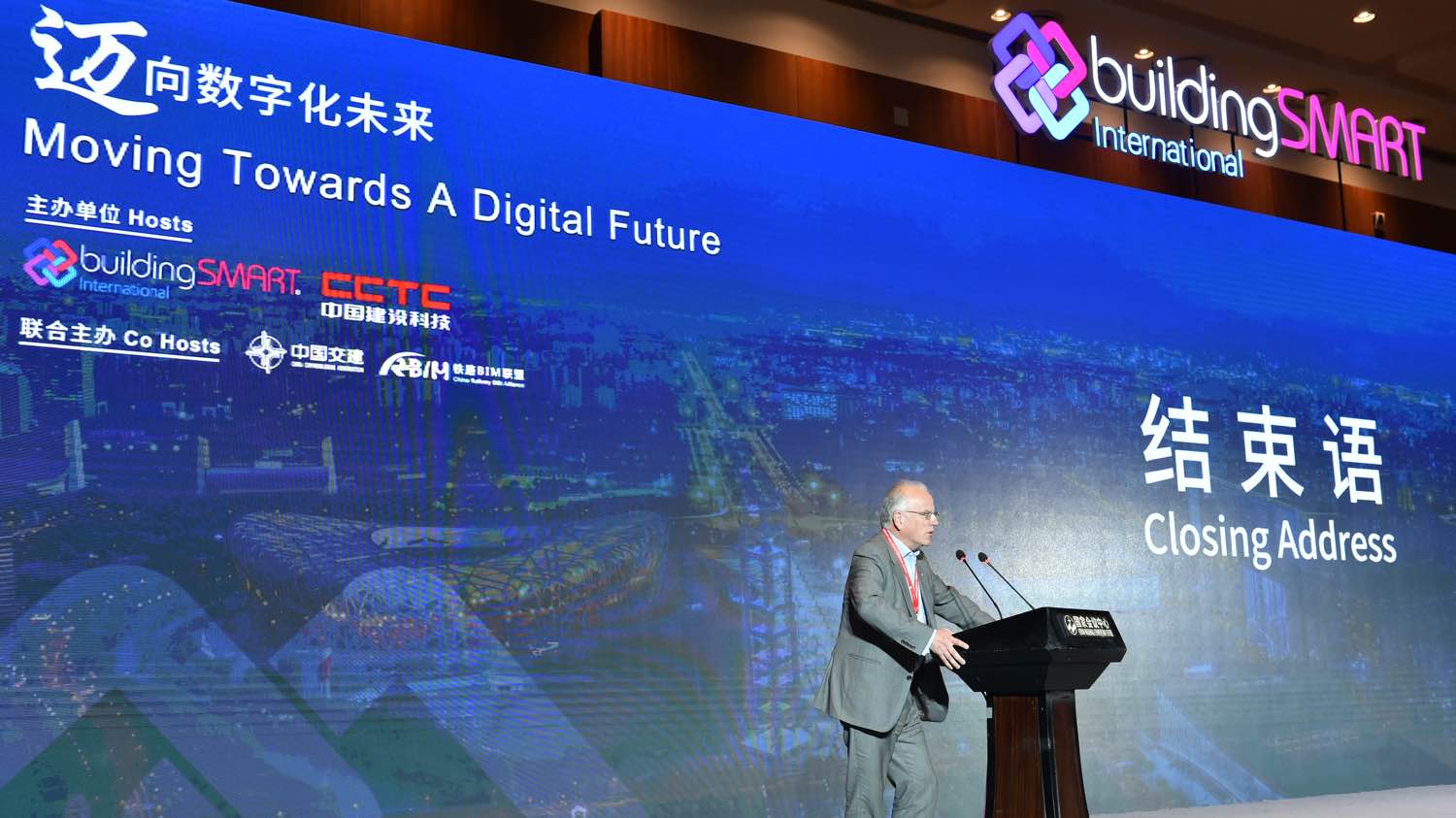The International Standards Summit, Beijing, China 28-31 October 2019
The world needs open standards. This was the bold statement from Richard Petrie - Chief Executive, buildingSMART International - during the latest buildingSMART International Standards Summit that was held in Beijing, China at the China National Convention Centre between 28-31 October 2019. The theme of this conference was “Moving Towards a Digital Future” which brought a new record-breaking crowd. The Summit itself was hosted by the China Chapter, CCTC with co-sponsorship at a strategic level coming from China Communications Construction Company (CCCC) and China Railway Design Alliance (CRBIM). The event included an opening plenary day, the China BIM Forum, two days of individual working sessions, the closing plenary, an awards dinner and a project site visit. Some of the key event highlights include;
- Over 1500 attendees
- 40,000+ people watched online
- Oracle announced as a Strategic Member of bSI
- National news channels covering the event
- Proposal for a new Power Room
- IFC Rail Reached Candidate Standard
- Women in Leadership lunch
- 11 award winners
It was undoubtedly a successful week. The attendance alone was a record and goes to highlight that buildingSMART is the go-to place to develop international consensus for solutions and standards development in the built asset industry. The success of the Awards Program in 2019 is a fair reflection of this and the outlook demonstrates real optimism for the future.
It is also worth noting that the conference was featured on a major national news channel in China and France. There was also an exciting announcement that “IFC Rail” has reached candidate standard.
The Opening Plenary - 28th October 2019
The opening welcome and remarks came from hosts for the opening plenary which included Richard Petrie, Chief Executive, buildingSMART International (bSI) and Sun, Ying, Vice President, China Construction Technology Consulting Co. Ltd. (CCTC). Following this, there was a welcome from the local host Xiu, Long, President, China Construction Technology Consulting Co. Ltd as well as an official welcome from the China Government. Next came a welcome from co-sponsor, Sun, Ziyu, Vice President, China Communications Construction Company Ltd. and a welcome from the other co-sponsor Wang, Tongjun, Vice President, China State Railway Group Co., Ltd. The seniority and support from these major organizations was a ringing endorsement of the importance of this summit and the support in making it happen. buildingSMART International would like to acknowledge the role played by all these organizations in ensuring this was so successful.
The first keynote came from Richard Petrie with his presentation titled “The True Value of Open Standards”. This presentation explained the value of buildingSMART to each stakeholder of the community. Mr Petrie also highlighted that when you look at the United Nations Sustainable Development Goals agenda, buildingSMART is committed to helping on many of the individual targets set. This, he points out, goes to show that the underlying the core mission of buildingSMART is important. This is reflected when you think about the word “sustainability” becoming more and more prevalent in things like “smart cities”, “clean sanitation and water”. Mr Petrie concluded that open and neutral data exchanges allow for greater flexibility of choice of software, sustainability for better futureproofing of projects and assets, efficiency by enabling the digital transformation, access to new international markets and opportunities for delivering long and short-term benefits.
Exciting news was shared, which includes the availability of “IFC Bridge” and “IFC Rail” which have both reached Candidate Standard. It was also announced that Oracle has joined as a Strategic Member, providing an exciting opportunity to enhance cloud-based solutions. The press release from the letter of cooperation between bSI and the Open Design Alliance (ODA) was shared which further strengthens the ability for implementation in software tools. Mr Petrie also shared the recent news that Léon van Berlo joined the management team as the new Technical Director, bringing leadership and clearer direction to the future of buildingSMART.
The opening plenary was divided into three topic areas under the umbrella of “Moving Towards a Digital Future”. The first topic covered in the opening plenary was “Digital Construction: How digital technology is changing the face of construction”. The first presentation titled ‘Delivering Digital Projects’ was delivered by Tristan McDonnell, Director and Sean McGinn, Associate Principal both from Arup. This address highlighted the relevance and importance of IFC for federating and coordinating design disciplines. An example of openBIM in practice was shared via a project called the Optus Stadium in Perth where the structural stack benefited from a federated design model for the coordination, quantity take-off and automated model comparisons that was enabled by buildingSMART standards. Mr McDonnell said that “IFC is a key enabler” and IFC is a big part of Arup’s digital transformation strategy. It was also shared that they still get client-driven requirement for IFC on many projects. The next presentation was titled ‘Japan's Construction BIM Leading the World to the Next Stage’ delivered by Kazumi Yajima, BIM Director, Kajima Corporation. Mr Yajima showed the progress being made in Japan and by Kajima Corporation in the development of BIM applied to smart cities, sensors and IoT devices. The acknowledgement that open data standards, like those provided by buildingSMART, can help to ensure both building and infrastructure projects and assets can align, such as BIM/GIS. The “society 5.0” message was clear: “super smart cities” are possible with an understanding of the complete lifecycle. Mr Yajima commented that society 5.0 is fully supported by the cabinet office in Japan and is fully supported by the local Chapter in Japan. Further examples of Kajima leading the way in robotics and smart connected devices showed the commitment from one of the leading construction companies in the world. The final presentation in this topic was titled ‘Digital Supply Chains in the Built Environment’ delivered by Enzo Blonk, Director Industry Engagement for Technical Industries, GS1 and Paul Surin, Global Lead for the Built Environment, IBM. This ‘DSCiBE’ project has been spearheaded by GS1, IBM, Cobuilder and bSI to tackle the need for digitization in supply chains. Mr Blonk and Mr Surin both highlighted the benefits of standards and the lack of harmonization if these are not followed. The importance of data templates was highlighted, as well as the role GS1 can play in unique barcodes or identifiers. A product data template is a way of defining properties for a product from a trusted and credible source. The initiative aims to connect customers to products in a more effective way than it is today. The approach has been to work collaboratively on a set of use cases to solve industry challenges to find a solution that works. The presentation signed off with the statement that “data is the new oil”.
Next was a panel discussion with the topic being “How can we speed up the digitization of the construction industry?” hosted by Léon van Berlo from bSI with the list of panellists being Yu, Jie President, China Design Digital Technology Co.,Ltd, Liu, Boying, General Manager of Science and Technology Department, China Communications Construction Company Ltd., Suo Ning Vice Director of CRBIM Expert Committee, China Railway BIM Alliance, Kazumi Yajima, BIM Director, Kajima Corporation and Mike Ramsay, Technical Director for Maritime and Aviation, Royal Haskoning. The panellists were asked questions based on their experience and their respective organization's outlook for speeding up the adoption of digitization in the construction industry with broad consensus that buildingSMART is well placed to help speed up the process.
During the break, there was the “Women in Leadership” lunch, hosted by Sun, Ying, Vice President, CCTC and Jeanne MacLeamy, Architect FAIA. This meeting aims to highlight the need for more diversity, leadership opportunities and allows for women leaders to share their experiences. Presenters from CBS, CCCC, CRBIM and Schiphol Airport all discussed topics relevant to their roles. This is now a yearly event that takes part during the Summit.
The second topic for the opening plenary was titled “Digital Asset Management: Why open standards help asset owners?”. The first presentation was from Karin Anderson, bSI Board Member and BIM Manager at Trafikverket, the Swedish Transportation Administration with the title of the presentation ‘Liberating Data - Climbing the BIM Stairs Step by Step’. It was announced that the Swedish government asked Trafikverket to take the lead in the national BIM standard development and implementation. The purpose and focus was to increase productivity, to focus on asset management and to find harmonization across BIM, CAD, GIS and PLM. A case study was shown, the Stockholm bypass, spanning over 21 kilometres in length and will take around 10 years to complete. With the growing use of the road network in Sweden, extra capacity is required. By structuring the information and using models for contracts, Trafikverket were able to realise real value in coordinating the work and utilizing BIM for many benefits, including road expansion. Next was Maya Tryfona, Data Engineer at Schiphol Airport with a presentation titled 'Optimizing Data Management at Schiphol Airport Using Open Standards'. Following on from the opening comments from Richard Petrie, this presentation focused on the need for open standards at a major airport. One of the main drivers for the airport was to know the location of their assets and to have a digital copy of reliable information. As a result, the airport would have better decision-making across the lifecycle of the airport by knowing more about their assets. An interesting stat shared was that 50% of aviation costs were related to assets. With no option of growing the airport, it was agreed that they needed to maximize what they had. It was felt that one of the key components to digitizing the airport was to follow and adopt standards. Schiphol use IFC for the BIM exchange, BCF for collaboration and IDM for the BIM protocols. Ms Tryfona shared some benefits, such as better efficiency savings, more transparency and increased innovation. Schiphol has played a leadership role in the Airport Room.
The final topic for the day was "Smart Cities: The compelling case for a digital city" with two excellent presentations. The first was from Boon Khai, CEO, Singapore Land Authority with the title of ‘Smart Cities - Integrating Digital Twin with Digital Workflow’. This presentation started with some context about the history of GIS. There was some information about the size of Singapore with just 5.7 as the total population, which brings many challenges, such as capacity planning. Mr Boon Khai shared their journey of mapping the country in 3D. This major project included mobile laser scanning data mounted on a car, covering every street and asset along the way. Their goal was to build a digital library of their nation. The topic of “Digital Twins” was then introduced as the central hub for multiple data inputs. It was stated that digital twins can be the method and means for delivering real efficiency gains, and that the SLA are firmly focused on developing this. The presentation ended with the promise that the SLA can do more to work with others to ensure global standards are developed and implemented. The next presentation in this session came from Jarmo Suomisto, Project Manager from the City of Helsinki. His presentation titled ‘Digital Twins of a City’ complimented the presentation from the SLA. Mr Suomisto showed some impressive 3D mapping derived from photogrammetric models developed to augment their existing GIS data. This data was used for a variety of use cases, such as energy analysis, wind analysis and solar potential. For all these use cases, the City of Helsinki was able to demonstrate detailed plans for the varying levels of detail (LOD) and other related data inputs. Many of the use cases cited were not always planned but came about as a result of available data. It was interesting to know that the City of Helsinki provide a web browser for direct access into their city model which is open to all.
Mr Boon Khai and Mr Suomisto were then joined on stage by Wolfgang Hass, Principle Expert, Siemens, Frank Weiss, Senior Director, Oracle and Aidan Mercer, Marketing Director, bSI who acted as host for the ‘Smart Cities – Fact or Fiction?’ panel. This debate followed different perspectives on what a smart city is and how useful it can be. It was quite quickly ascertained that smart cities are in fact already in operation today and was there more fact than fiction. The topic of digital twins was also mentioned, and its importance was again highlighted as well as the need for an open CDE.
Next up was Neil Petersen, CEO, Open Design Alliance (ODA) who shared some insights on what the ODA does and why the letter of cooperation between ODA and bSI is a real game-changer for the implementation of open standards. The ODA focuses on interoperability across design applications and authoring tools over 1200 members companies. The key message from Mr Petersen was the crossover between open standards (from bSI) and open standards implementation from the ODA and that the relationship will benefit the common users of all tools and solutions.
The penultimate presentation for the opening plenary came from bSI’s Technical Director, Léon van Berlo with a presentation titled ‘Future Technology Vision’. This began with some nice continuation of the smart city topic with the need for use in automated services, smart buildings and IoT devices. The current state of IFC was highlighted with an example of an ifcWall. With opportunities for improvement, Mr van Berlo showed how the kernel of IFC is not strict enough anymore for actual interoperable and reliable implementations. Today, there are too many ways to describe an object or geometry. It was then announced that bSI is working towards a situation where the core of IFC and the domain extensions will be published on Github as UML for a more modularized approach to the technology. Mr van Berlo stated that “IFC is a vital part of the digitalization backbone towards an integrated digital future”.
Finally, the day was rounded off by a presentation from Richard Kelly, Operations Director, bSI. His customary rally for the week to come, came as a timely reminder for the need for open standards and good asset management. His leadership of the Solutions & Standards Program has ensured more standards are being worked on (over 20) and more collaboration across Rooms. There was an exciting announcement that there is an intention for a Power Room which should start in 2020.
The Awards Dinner and China Construction Digital Conference Appreciation Night
The awards ceremony which was held shortly after the opening plenary was a spectacular event. With a sell-out crowd of almost 400, high-quality finalists in attendance and wonderful hosting from the China Chapter made for a memorable evening. The audience was treated to some spectacular traditional Chinese dances with colourful backdrops and cultural music that added to the whole experience. The event was welcomed by Aidan Mercer, Marketing Director of bSI and Lai WEI, Secretary-general of buildingSMART China Chapter.
With 109 project submissions, the workload for the 67 jurors was significant. High-quality projects geographically spread and with ranging disciplines made for an very interesting competition. 2019 was a year the team introduced “finalists” for each category meaning those selected as finalists would need to present to a jury which would result in a decision and agreement on the winning project per category. You can see all finalist presentations located here. Awards finalist presentations.
Submissions for 2020 will open in the New Year and the team will announce new developments soon.
Days Two and Three – 29th and 30th October
Days two and three began with the working sessions which are divided into Rooms. The Rooms consist of Technical, Building, Infrastructure, Railway, Regulatory, Product, Construction and Airport. This Summit saw more cross-pollination between Rooms, with joint sessions planned and delivered for common topics, such as the open CDE API project and Infra Rail harmonization among others. The verdict on the working week was that it was a tremendous success and Richard Kelly, Operations Director stating that “The Room leadership teams are clearly defining the needs of their industry domains and setting plans to respond to these. The bSI Process is now becoming just the way things are done around here which is driving pace and consistency of output. The Rail project has set a new benchmark for digitising asset management and the next challenge is to expand the operations to include software validation for this and all future standards.”
You can find out more about he the closing plenary in the detailed review and conclusions delivered by each Room leader on the Closing Plenary section.
This Summit hosted the China BIM Forum which was held in the same venue with a big focus on the use of BIM in projects, in China and around the world. Some of the finalists from the Awards Program presented their projects. This is a continuing theme following on from Dusseldorf and the “BIM at its Best” program which is designed to engage with new audiences and to give the local market insights into buildingSMART.
There was also a roundtable featuring key figures from the community who discussed the topic of “Smart Cities”. 26 people attended with the consensus that a clear value and definition was needed from bSI and a potential working group moving forward.
Strategic Advisory Council and Board Meeting
The Strategic Advisory Council (SAC) brings together Strategic Members and invited guests as well as Board members to discuss the strategic direction of buildingSMART. As part of the membership benefit, guests can advise and provide feedback to the leadership team spanning various topics. This year’s council meeting was very productive and further announcements will follow in due course. It was announced however that Hong Kong was approved by the Board as a new Chapter. We welcome the team.
Closing Plenary
The closing plenary continues with the customary wrap-up, conclusions and next steps from each Room. The morning was started by Richard Kelly from bSI who highlighted the need for a strategic roadmap. The clear points shared with the audience were;
- Schema modernization needs to meet current demands
- Tooling and formalizations
- Extensions to the schema and harmonization
- Vendor implementations
- User ecosystem requirements
First up was Jeffrey Ouellette who provided an update from the Implementation Support Group (ISG). With a recap of 2019 meetings in Maryland, USA and Helsinki, Finland, Jeffrey shared some of the key takeaways. It was also shared that the next meeting would be in Pune, India hosted by Bentley in the Spring of 2020. One of the key takeaways is how the ISG has managed to get competing organizations to work together on providing solutions for the industry. There was also a sharing of the updates and improvements to the communications channels such as the Forum, the new Technical site and more open sourcing on GitHub.
Léon van Berlo provided an update for the Technical Room and highlighted a lot of work done on linked data and linked ontologies. There had also been a great response to the open CDE API project work done with Oracle and the associated companies. There is a growing need for “Digital Twins” to be relevant and available at buildingSMART. There is also a design for a closer look at IfcSensor for linking IoT and connected “things”. It was also highlighted that the bSDD needs focus moving forwards.
Tiina Perttula provided an update from the Infrastructure Room and shared the overall project program from 2017-2020. This includes IFC Road, IFC Bridge, IFC Ports and Waterways, IFC Infra Extension, IFC Tunnel and the Common Schema project. There was mention of the ongoing collaboration with the CEN TC 442 work as well as the Integrated Digital Built Environment (IDBE). Tiina highlighted than ongoing cooperation was needed with other standards bodies like ISO, CEN and W3C to ensure open and shareable information could be used across the infrastructure lifecycle. There was also a call for funding for these projects to ensure they can meet their deadlines.
Frédéric Grand provided an update for the Product Room and began with the thanking Roger Grant for his time as the leader. Frédéric shared some bSDD updates to the bSDD Policy Statement. He also mentioned that the Product Room is not the bSDD, but in fact all about products and manufacturers. There was a strong statement that the Product Room should work with other Rooms to share experiences and provide more engagement and to develop work on new extensions. There was also a proposal for a new working group.
Nick Nisbet provided a report and resolutions from the Regulatory Room. Work is continuing on the E-Submission processes, regulatory interoperability and automated rule checking. The need for a” refresh” of its mission by better defining a roadmap and a clear purpose for the room was also expressed. More joint sessions are required moving forward as well as the new for more use cases as the current scope is too limited.
Ken Endo provided an updated from the Construction Room. His message was focused on the quest for 4D and 5D BIM dimensions. This includes time, schedules, cost, operation and the full lifecycle of construction projects. Ken provided the position for buildingSMART in this topic, such as IDMs, MVDs and BEPs. There were many highlights from presentations given throughout the week including topics that included other rooms. Topics such as digital twins, BIM+ GIS and product data templates were also highlighted.
Alex Worp provided an update from the Airport Room with further progress having been made on the integration between BIM and GIS. The example of the ongoing work here was from Schiphol Airport of the need to develop a GIS Platform to IFC workflow to digitize their assets was again the theme for this conclusion. This includes solving things like wayfinding. Phase 2 includes work with digital twins enabled by a common data environment that can help support their asset management approach. The focus moving forward is on continuing collaboration and developing rules for open source.
The Building Room update came from David Ivey with an update on the roadmap. There was also an update from the status of some of the ongoing projects and news of joint sessions such as linking ontologies. There was also news of some local Chinese projects such as SSO and MVDLite which is a lightweight version of MVDs. There was also news about new projects such as “Energy MVD”.
Winfried Stix provided an updated from the Rail Room with the news that “IFC Rail” has reached Candidate Standard. This means the global community is now able to provide comments and feedback. This is milestone delivered by the team is a major development for buildingSMART and a significant piece of work. This is the largest project ever undertaken in buildingSMART. It was announced that software vendors have been invited in for implementation and the team is now focused on the next phase of the project. There was also an acknowledgement that this needs to be part of the Common Schema work to ensure interoperability between IFC infrastructure schemas.
Randolph Mews from ProMaterial presented on the topic of “UniversalTypes – Value proposition and end-user engagement”. An overview of what it does was and a demo from the UniversalTypes Center showed its functionality. It was stated that today, the construction industry is missing a common language and that this particular use case is for online channels only. This engine will provide a unique language for the construction process and UniversalTypes will make construction materials easier to find. For more information, please visit https://www.promaterial.com/
Mark Baldwin, Leader of the Professional Certification Program provided an update from the highly successful program. Since it’s rollout and launch, it has successfully delivered openBIM training and set a global benchmark for competency assurance. It was announced that 15 Chapters are currently involved, and 21 countries have joined in. There was also mention of what the future will bring and exciting developments moving into 2020 and beyond.
Finally, Christophe Castaing provided an update from the “IFC Bridge” project which recently made Candidate Standard. This showed the various scopes of working including the different phases, such as the conceptual model, specifications and implementation plan. The standard itself will provide huge added value to the industry and is seen as a key development for the community. Examples were shown of how this will be implemented technically.
Day Four – 1st November 2019
BIM Project Visit
On Friday the 1st November, there was an organized visit to the National Speed Skating Oval (NSSO) in Beijing. This morning site visit was organized by the China Chapter and allowed guests to see the current construction progress from an iconic building located in Beijing.
Conclusion
With recording breaking crowds, and more engagement that ever, it is clear that buildingSMART is in a good place. There were some major highlights during the Summit and a broad range of topics. “Moving Towards a Digital Future” helped set the tone from the first day, and the output continued from there. Aidan Mercer, bSI Marketing Director said “I’m delighted to have ensured this event was a success. Working with buildingSMART China was fantastic and the local support we got was undoubtably a major factor behind such an amazing event. We now look forward to 2020 with exciting events in Norway and Canada.
The topic of ‘Digital Twins’ came up on many occasions, in many different presentations and meetings. It’s important that bSI can provide a place to develop digital twins.”
Richard closed the summit thanking the Chinese hosts and Chapter for their extremely generous hospitality for what had been a truly spectacular event underpinned by a clearly strong sincere and growing commitment to help the buildingSMART community bring open standards to market. He also noted his pride in the progress achieved within the projects and rooms and in the growing base of partner organisations with whom we have serious working relationships. The summit has been a great milestone – revealing graciously the next step of the journey!

